I love the Battle of Island Number 10. Almost always when people like you and me look at a map of a battle and go, "Well, why didn't General So-and-so just do XYZ, he could have flanked the enemy and then... yadda yadda yadda." This sort of armchair generalship decades or centuries later is almost always stupid. Generals generally aren't total idiots, and scholars who really look at the circumstances of a battle can almost always point to some inconvenient facts for an armchair general. Maybe the terrain was flooded, or maybe the troops were dead tired, or actually the enemy could have easily countered with another tactic, or it was dark and raining, and there were no maps, and the troops would have gotten lost and it was a 50/50 shot that the troops would have gotten turned around attacked their own side's trenches there, or maybe the general didn't have the battlefield awareness to obviously end his troops into the breach right then you %&^*#! idiot! But this is one of those rare exceptions. I can almost image a some frat bro still drunk from partying the night before, somehow making it to class in morning, looking at the slide showing the map of the battle, raising his hand and interjecting with something like, "Uhhh, so why didn't the Union just, like, cut a canal across that little bit of land, sail their ships through, and then outflank the badass fort the Confederates made instead of trying to attack it head on." And for once... that is basically exactly what the Union did. And this is why I love the Battle of Island Number 10.
Alright, so this is the US Naval History Podcast, I'm your host, Chase Dalton, and we are today, finally, talking about the Union advance down the Mississippi River, and the capture of the first obstacle on the Mississippi itself that the Confederates have erected, at Island Number 10. Why Island Number 10, well, because of lack of imagination and because is was the 10th island counting north to south on the Mississippi River starting from where the Mississippi splits from the Ohio River at Cairo, Illinois. If you look on Google Maps today you can see that Island Number 10 has eroded away in the 162 years since the battle, but it was never much of an island, more of a convenient (or inconvenient, depending on if you're doing the blocking or not) sandbar, roughly 1 mi long and 450 yd wide, and only about 10ft above low water.

The Confederates chose Island Number 10 as their northernmost stand on the Mississippi because it was an absolute beast of a defensive position. Its at a place where the Mississippi does a very tight double bend one right after the other, with the famous Island Number 10 in the middle of the channel of the first bend, and the fortification at New Madrid, Missouri at the top of the second bend. Because boats have to realllly slow down to do a sharp turn, that makes sharp turns the perfect spot to build a little fort and pound any of those suddenly slow boats into oblivion. At least in theory. Bends also create big embankments that are nice to build gun batteries on that can be used to fire down on any passing ships. The ones here aren't huge, but they are 30 ft high in places and the Confederates built a bunch of little fortifications and batteries that were somewhat protected by being on a big bank, and had a good firing position down on the river the the Union would have to deal with. The double bend at New Madrid, and then again just downriver at Island Number Ten was a doubly perfect place to make a stand to stopping any Union warships and transports that might want to steam south into the Confederate heartland. This was important to the Union because rivers are logistics highways inside of your own territory but they were also logistics highways to attack the enemy with. Because the Union had the industrial power to crank out a river fleet that the south could not match, the Confederates had to resort to river fortifications to secure their rivers, and the Union had to beat these forts into submission one at a time to keep the advance rolling.
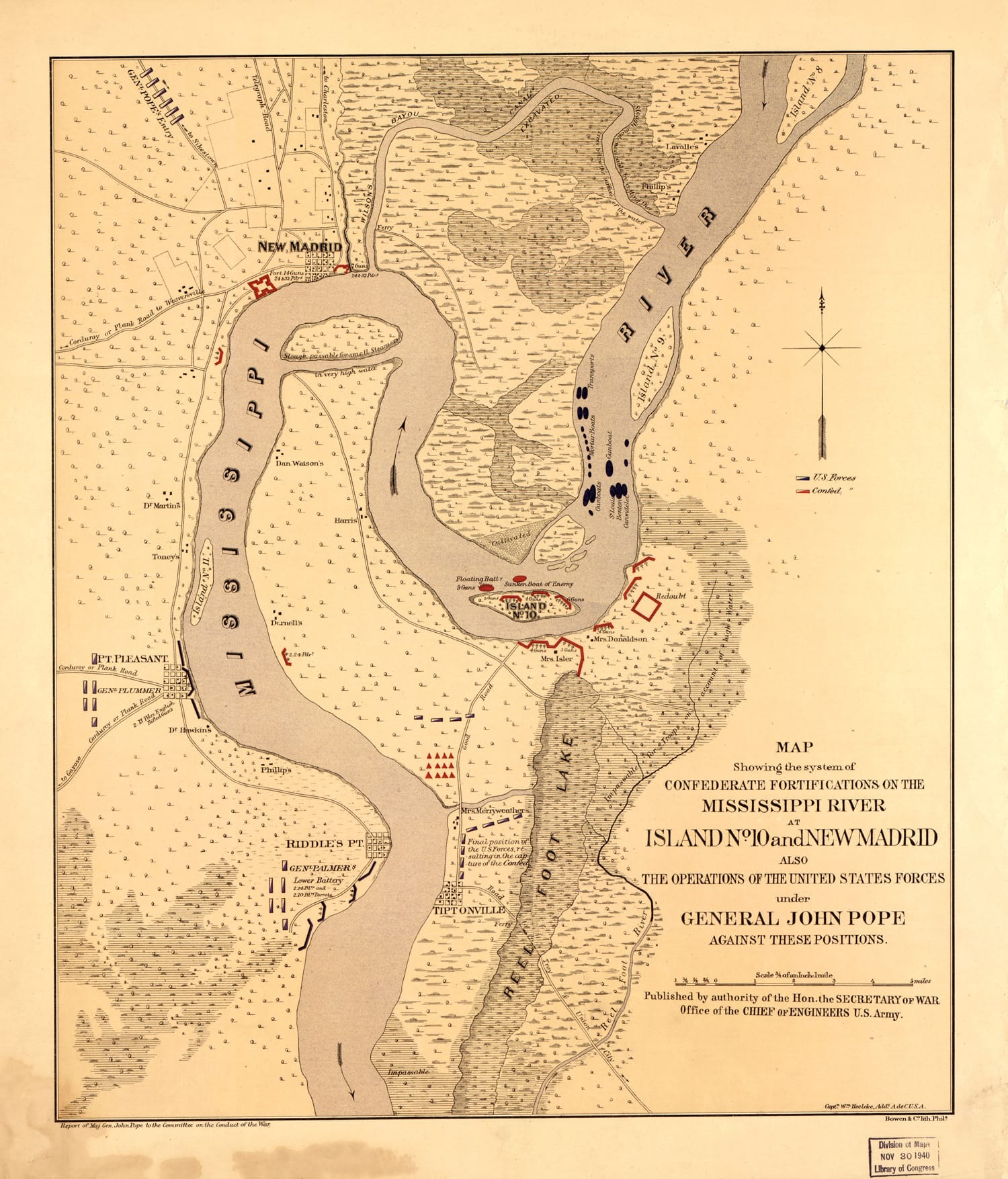
Before I begin, I'm going to plug the website, USNavalHistory.com which I've linked in the show notes, which has the transcript, maps, and also, the ability to donate to this fine show so I can stop losing money buying software and books to run the show. You can donate at whatever level works for you financially, whether you're at the $3/month level or are able to afford a higher level of support, I'd appreciate anything you can give.
Union Brigadier General John Pope, commanding the Army of the Mississippi, must eliminate these two strategic defensive points, Island Number 10 and the weaker fortification at New Madrid, Missouri in cooperation with Flag Officer Foote's Western Flotilla fresh from a quick refit after the punishment inflicted on it by the Battle of fort Donelson, and reinforced with brand new mortar boats.

The Confederates had of course realized that the Union was going to try and take the mighty Mississippi and cut the Confederacy in two, and so almost immediately after they declared their traitorous independence, Southern Generals began planning the defense of the Mississippi. Island Number 10 was the logical spot for the first defense, and in mid-August, 1861, erection of earthworks began with crew of several hundred slave laborers. But the occupation of Columbus, Kentucky, diverted men, materiel, and attention away from the project. Battling chronic shortages of labor and tools like shovels and wheelbarrows, fortifying the island continued only sporadically throughout the first summer and autumn of the war. Attempts to employ unarmed volunteer regiments in construction are resisted because the Southern soldiers objected to being assigned tasks alongside slaves. There were shortages of the right type of cannon carriage, and of cannon, and basically everything else, because the South was an extractive economy that just didn't produce stuff and had no business fighting the first modern war...but of course the fact that this was the first modern war and the balance of power would forever go to the side with the most industrial capacity wasn't clear yet.
With the collapse of the general western defensive line when Forts Henry and Donelson fell in February of 1862, Confederate war planners realized they had a grade A emergency on their hands and pushed every available resource to reinforce New Madrid and Island Number Ten against the inevitable and probably imminent Union attack. Union Major General Halleck, the commanding general of the theater, sent the first Federal troops towards Island Number Ten by rerouting troops intended for Tennessee to Commerce, Missouri, and selecting Brigadier General John Pope to lead them. Pope had spent most of 1861 fighting guerrilla bands plaguing Missouri, but on February 18th, Halleck ordered him to take charge of the Army of the Mississippi and crack the Rebel defensive lines at Island Number Ten and New Madrid.
On February 21st, Pope leads his 25,000 man force south to secure Sikeston as the nearest railhead to supply operations against Island Number Ten. On March 1st, Pope's Federals encounter the first Rebel resistance from the secessionist Missouri State Guard. If you remember from the last episode I talked about how the clean Civil War border lines were a bit of a fiction and how the border states had conflicting governments? Well, Missouri was one of these border states, and while officially in the Union, large portions of the state supported the Confederacy. Anyway, the Missouri State Guard was no match for the Army of the Mississippi, it got smashed, and on March 3rd arrived outside of New Madrid, the fortified town at the "top" of the second of the two tight U-bends in the Mississippi.
The same torrential rains all spring which had flooded the battlefield at Fort Henry meant that the Mississippi was constantly flooding its banks. This presented problems just getting to the town of New Madrid, but also gave the Confederates a tactical advantage on because their gunboats could fire over the New Madrid levee on any attacking column crossing the flat terrain surrounding the town. Without any heavy artillery of his own, General Pope keeps his main force out of range of the Confederate boat's cannon, and dug in to surround New Madrid while waiting for Admiral Foote's river flotilla to arrive and clear off the Confederate gunboats.
At the same time, Confederate General Polk issued the order to evacuate Columbus, Kentucky, about 27 miles northeast of Island Number 10 on the Mississippi. Opposite the bluffs of Columbus had been where Grant made his debut at the Battle of Belmont. Their impressive defensive position that so much effort had been put into making on the bluffs overlooking the Mississippi were taken almost without a shot because the Confederate could not control the river systems to their east. With the fall of Forts Henry and Donelson, Columbus was about to be surrounded and captured, and Polk could not afford another stupid last stand and mass capture of an army like had happened at Fort Donelson. The first Confederate soldiers from Columbus arrived to reinforce Island Number 10 on February 24th, which allowed the commander of the garrison at Fort Thompson in New Madrid, to assure General P. G. T. Beauregard that they would "make a splendid defense." Confederate Brigadier General McCown soon assumed command of Confederate forces around New Madrid, having been one of the officers to have surveyed Island Number Ten the previous summer.
Battling constant rain and soggy terrain, McCown raced to emplace additional artillery; by March 13th, nineteen guns are mounted on the island with another twenty-two on the Tennessee shore, and ten days later, the number had risen to fifty-two cannon. Nonetheless, the rising Mississippi continues to imperil the Confederate position despite efforts at sandbagging or pumping. Some help does appear in the form of an improvised Confederate naval squadron commanded by sixty-two year old Commodore George N. Hollins, one of the few U.S. Navy officers to join the Confederacy. Although lacking full crews, his Mississippi Flotilla consists of seven converted river steamers and the two-masted screw propelled brig CSS McRae and the floating battery CSS New Orleans, an armored barge that could not move under her own power, but was equipped with 20 cannon and could anchor in the river for some semi-mobile firepower. The CSS New Orleans was floated into position on the north side of Island Number 10 to assist in closing off the main shipping channel.
Although temporarily stopped from advancing by rebel artillery at New Madrid at the top of the first and northern U-bend in the Mississippi, General Pope kept probing the Confederate defenses. On March 5th, he dispatches Colonel Joseph Plummer to secure an isolated Confederate emplacement on the Mississippi at Point Pleasant ten miles to the south. Plummer's men seize the Confederate position and man the guns to now harass Confederate river traffic supplying Island Number Ten instead. For several days thereafter, Commodore Hollins at Island Number 10 responds by furiously shelling the Point Pleasant position, but is repeatedly frustrated as Union gun crews just withdraw under heavy fire and then return when Rebel gunboats draw off. Plummer also places an additional unit, Battery M of the 1st Missouri Artillery, at Riddles Point directly across the Mississippi from Tiptonville, Tennessee - the only land route which the Confederates can use to retreat from Island Number Ten. The Confederates can't abandon another position on the Mississippi, but unless they can get reinforcements, this may turn into another Fort Donelson-like disaster.
On March 12th, Brigadier General Pope receives the slow-moving heavy artillery he needs to point New Mardid into submission. With the help of an eight-inch howitzer and three 24-pounder siege guns shipped from Cairo, and the combined efforts of the 10th and 16th Illinois who had been digging gun emplacements while under fire within 800 yards of Rebel lines, the guns ready to fire by dawn the next day. After a day of shelling, Confederate General McCown summons his commanders and gunboat captains for a war council aboard the CSS McRae. The Confederate naval commanders know that Admiral Foote's ironclad squadron is coming down the Mississippi. Commander Hollins believes his entire squadron will face annihilation if forced to confront even a lone Union ironclad, since the Confederates have none. At the war council, the Confederate Navy insists their vessels must withdraw downriver and that the infantry and stores must be loaded immediately, or nothing might be salvaged. The Army agrees, and they hatch a plan to withdraw the entire garrison that same evening, but poor execution and bad weather quickly wrecks an orderly withdrawal. At 11:00 PM, a strong thunderstorm commences just as the retreat begins. Confusion reigns, several civilian transport commanders refuse to obey orders, and efforts to remove the heavy ordnance utterly fails. The Confederates are forced to spike their cannons rather than retreat with them to fight another day. By dawn, the retreat is complete.
On the morning of March 14th, two deserters appeared bearing a white flag, and informed Pope that the town was deserted. General Pope marches his forces into New Madrid and telegraphs to St. Louis that, "to my utter amazement the enemy hurriedly evacuated the place last night leaving everything." Besides occupying an important strategic position, Pope also counts spoils including 33 cannon, thousands of small arms, and entrenching tools, as well as horses, mules, wagons, and tons of ammunition. Union possession of New Madrid endangers Island Number Ten, but Pope cannot cross the river without transports and gunboats to protect his troops, since the Confederate naval squadron could make a sortie back up the river and easily sink any undefended small boats without the protection of a Union fleet. On March 15th, the Union Navy Western Flotilla and its ironclads under the command of Flag Officer Foote arrive, fresh from a very quick refit after the punishment of taking Fort Donelson with General Grant. It was the aftermath of this campaign that had delayed the Navy, as cracked iron plates needed to be replaced and Flag Officer Foote had sworn he would "never again...go into a fight half prepared." This time, Foote had the mortar boats he wanted, and experienced crews had been recruited from the Great Lakes region.

Fighting in the Mississippi was different than fighting on the Cumberland and Tennessee Rivers. Engaging Confederate forts on northward flowing rivers like the Cumberland and Tennessee, allowed Foote's steam-powered vessels to "stand on their wheels," basically putting on a tiny bit of power to counter the force of the current. There was enough flow over the rudders this way and allowed the ships to maintain their battle positions with their heavily armored bows facing the enemy. If the ship were disabled by enemy fire, it would simply drift with the current back to safety. But the Mississippi River flowed southward, and any gunboat knocked out of action would be swept into enemy hands. Experiments to test whether the ironclads can fight while backing upstream against the current fail even when the twin anchors are placed astern to try and hold the ship in place. All of this means that Foote had to take a more cautious approach to deploying his squadron than he had at Henry and Donelson.
Finally, at 10:00 AM on March 14th, Foote's squadron of 7 ironclads and one timberclad cast off accompanied by ordnance boats, fourteen mortar boats towed by steamers, and several transports loaded with troops. The Union flotilla arrived off Island Number Ten around 0900 on March 15th. However, prospects for immediate attack are not good, as the Mississippi's flood current is strong, and as Foote tells Secretary of the Navy Gideon Welles, "Island Number Ten is harder to conquer than Columbus, and island's shores are lined with forts, each fort commanding the other above it." Some of Foote's officers want him to just take the Western Flotilla and steam past Confederate fortified points and wreak havoc all the way south to New Orleans as a raiding force. This is actually a plan that the Confederates think Foote might adopt and they dread it since Union control of the Mississippi would be a disaster, but there are several problems with this. With chokepoints still in place, supplying the flotilla with enough coal and supplies would be tough. But more than that, the war strategy was to conquer, not to raid. This meant that the forts had to be demolished and captured one by one, so that there were no river impedances, and enough supplies could be ferried south to support a conquering Army.
And so, to demolish the forts at the second U-bend in the river, Foote places his eleven mortar boats under the command of Army Captain Henry E. Maynadier. These mortar boats are flat bottomed sail powered scows that could also be towed by steam ships, about 50 feet long and 25 feet abeam. Their sloping, boiler plated bulwarks enclose a 17,000 pound seacoast mortar that fired a 13-inch, 230-pound shell several miles in a high arc over any defending walls, propelled by 20 pounds of gunpowder. They were so powerful that the mortar crews had to huddle outside the bulwark and almost all of the men who manned them would go on to suffering hearing loss, and probably some sort of traumatic brain injury as well if I were to guess. President Lincoln himself took a personal interest in that ensuring the mortars had enough ammunition to "rain the Rebels out" of their entrenchments by "treating them to a refreshing shower of sulphur and brimstone."
On Sunday, March 16th, Foote's gunboats probed enemy positions while the mortars test fired to get the right range. In preparation for combat, the ironclads USS St. Louis and USS Cincinnati are lashed on either side of the flagship Benton, so that if one vessel is disabled, the combined power of the other ironclads could fight the current and prevent her from floating downstream. At 1100 on March 17th, the ironclad USS Mound City opens fire on Rebel positions, and is soon joined by the rest of the Western Flotilla. Heavy fire is concentrated on the Tennessee shoreline fortifications, and on the Belmont Battery located at the tip of Island Number Ten. Confederate guns reply briskly, although outmatched in range by the heavier naval cannons. The Confederate gunners were fighting up to knee deep in water in some positions due to the continuing flood conditions, putting them at a disadvantage to the floating Union firepower.
The Cincinnati is struck several times, and the Benton takes four direct hits, with one 8-inch solid shot smashing through the upper deck and passing the entire length of the vessel before finally falling spent upon the commodore's writing desk. The only fatalities in the squadron, however, occur when one of the USS St. Louis's rifled guns explodes, killing three men and wounding a dozen more. By day's end, little serious damage has been done, although naval observers witness their shells cutting up the enemy's earthworks; more water is let into some of the shore batteries, a 64-pounder is dismounted, and two Confederates have been killed, but nothing more. The engagement on March 17th ends at 1900 as the gunboats return to their anchorages, while the mortar boats maintain a steady hail of giant cannonballs throughout the night. Admiral Foote is more than content to let the mortars pound Island Number Ten into submission. As Union leaders begin to settle into a siege, the Confederates undergo a command change; McCown is promoted to Major General and sent to Fort Pillow, while Brigadier General William W. Mackall is dispatched to replace him. Mackall is a forty-five year old West Pointer from Maryland who had been twice brevetted for bravery in the U.S. Army, but had resigned at the outbreak of the Civil War.
When General Mackall arrives, he finds the part of the action that I refer to in the beginning as an armchair general's plan. Rather than attempt to fully pound Island Number Ten into submission, General Pope is cutting a canal straight through the marshy, semi-flooded part of the river bend that forms a "U.' Island Number Ten form the bottom of this "U" bend in the Mississippi, and if Pope's men can cut a canal through the narrow part of the "U", the Union squadron along with all the supply ships and troop transports necessary can just bypass the fort altogether. This really is a cool, outside of the box plan, and I love it. Pope is actually cutting from the New Madrid side of the "U" which is downriver, meaning farther along the Mississippi as it flows generally North to South, but New Madrid because of the two U bends is actually farther North than Island Number Ten, and that is where General Pope and his army are, cut off from Foote's Western Flotilla which is upriver on the other side of Island Number Ten, and this isolated from New Madrid, Pope, and his army. It's a little confusing, but I have a maps on the show page of USNavalHistory.com that show the geography here, check it out, the link is in the show description.
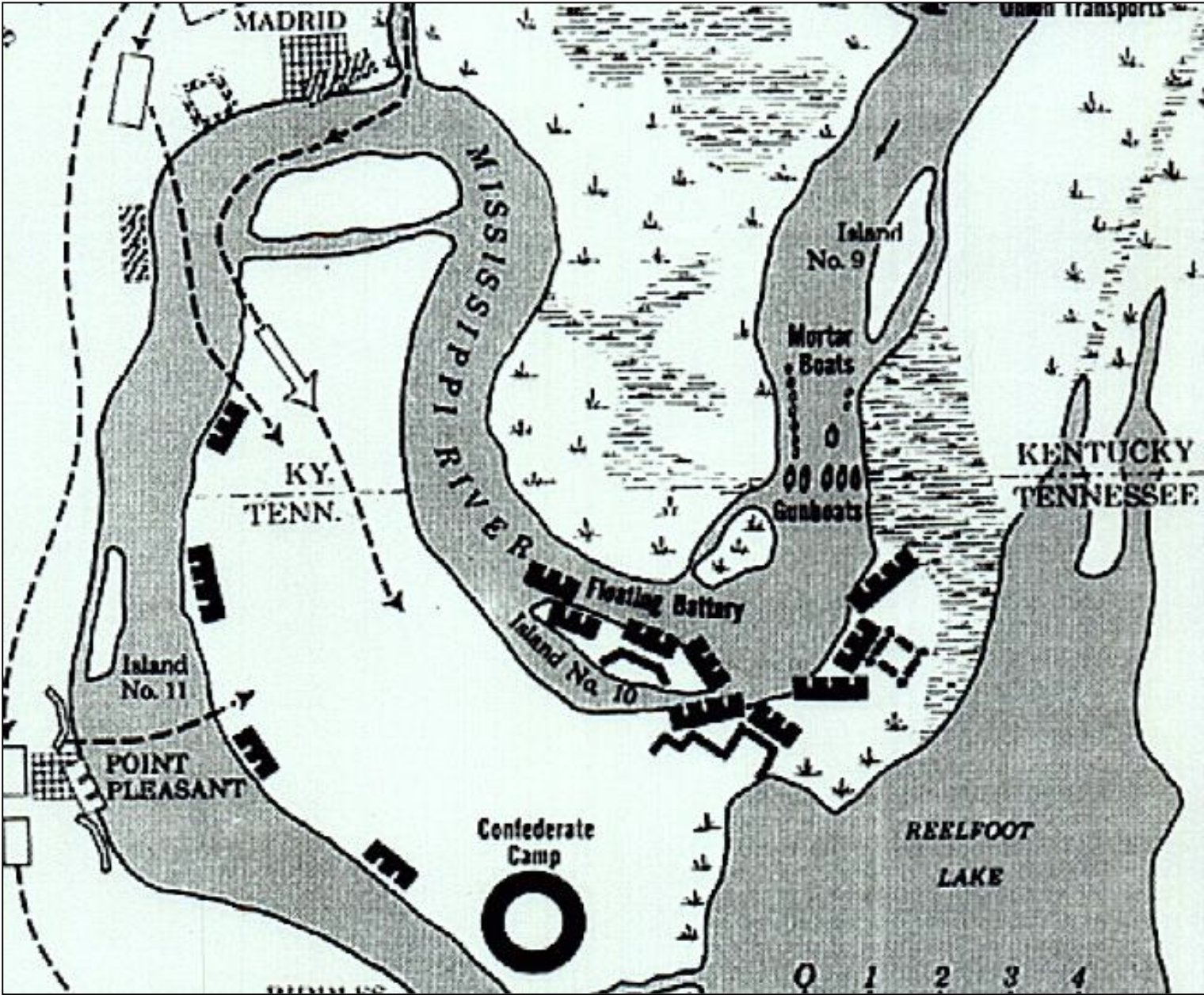
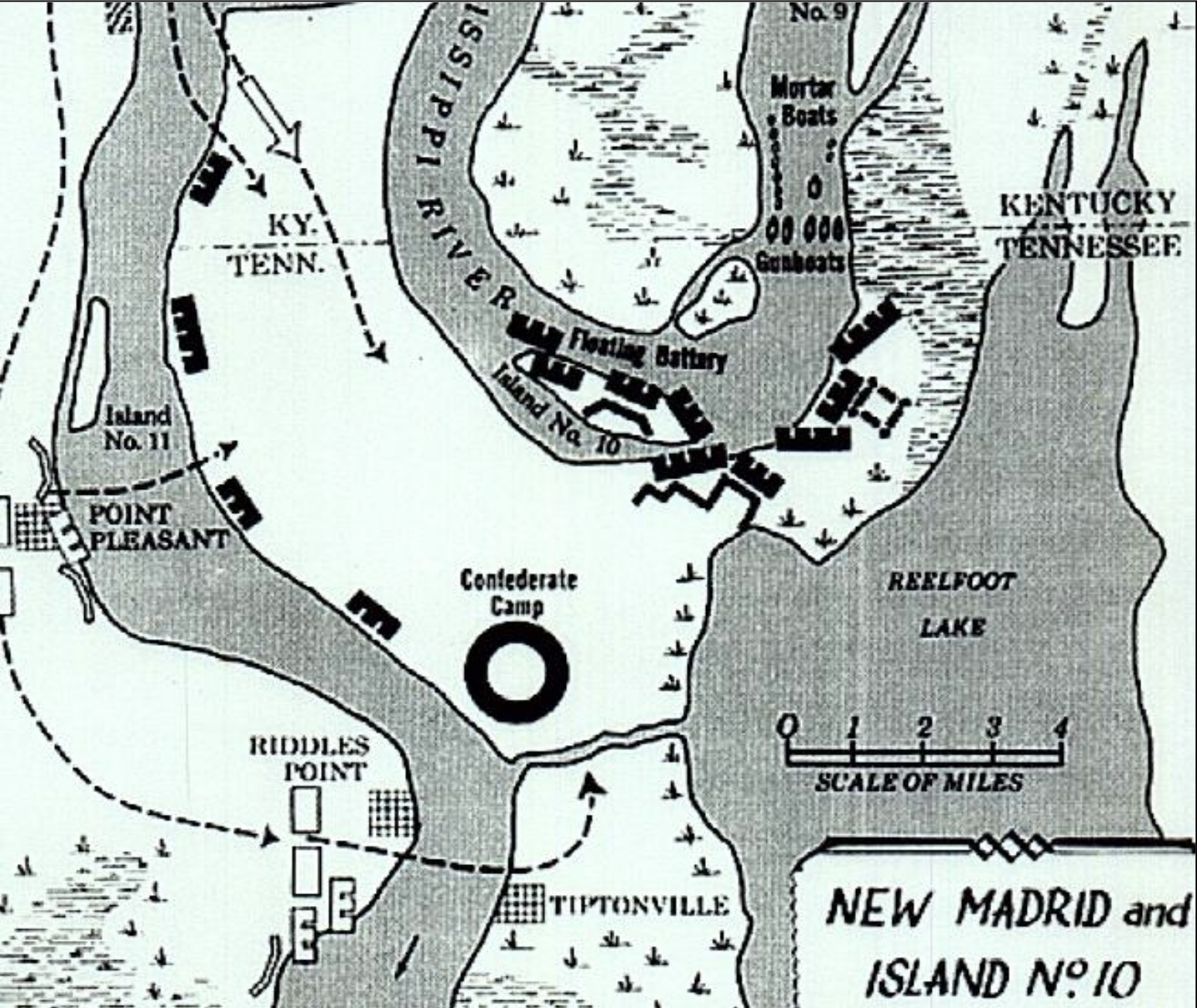
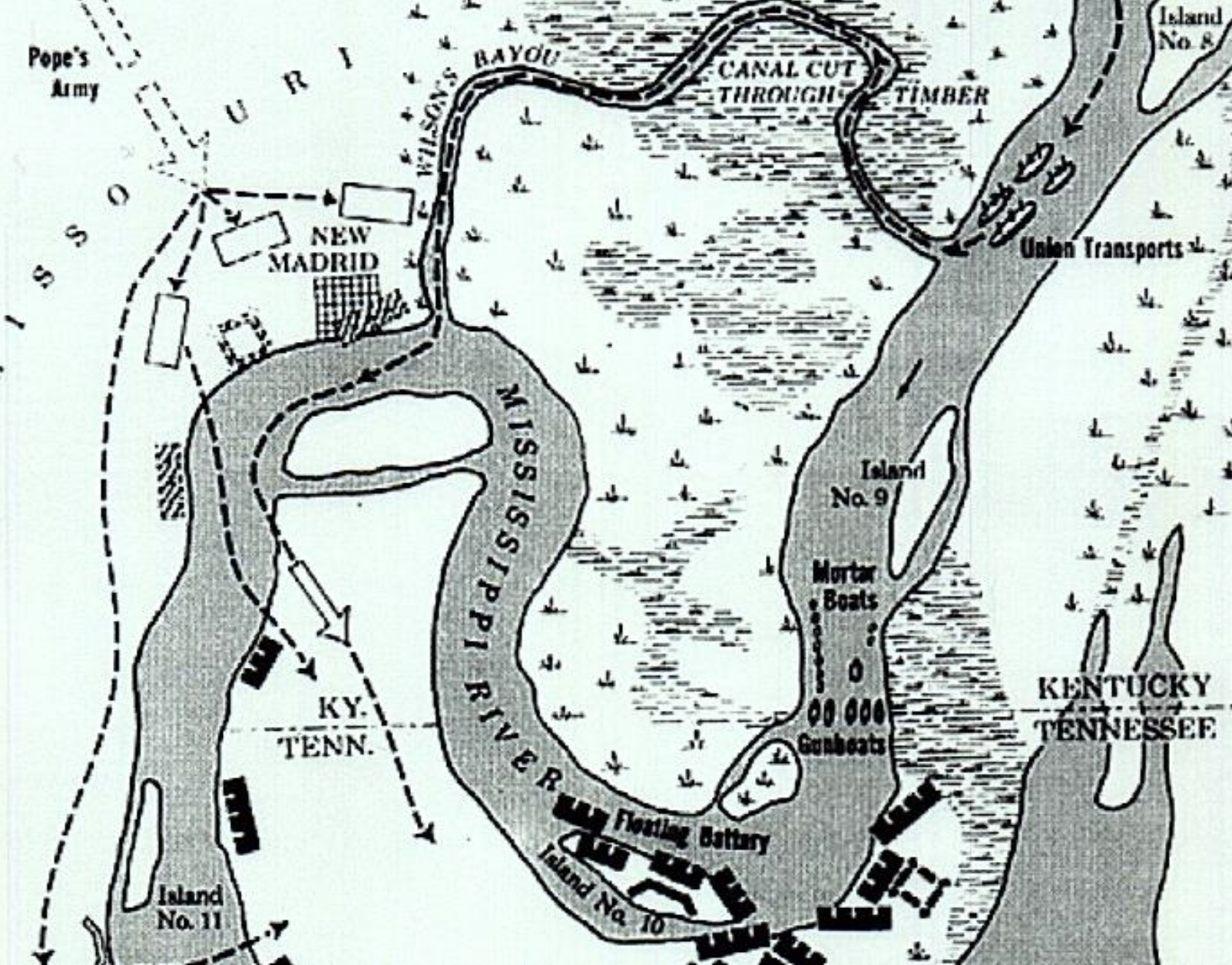
Confederate General Mackall arrives and is immediately aware that if this canal gets built, he's lost the battle. General Pope has 30,000 men, and when he arrives at Island Number Ten to take command, he can't get even get an accurate estimate of the number of men under his command. It may be as low as 2,500 effectives on hand for the defense of the island, the Tennessee shore batteries, and to man the fifty guns along a twenty-five mile stretch of river. However, many of these "effectives" are men are sick with measles or mumps and others lack proper arms, with officers reporting that many more men have broken down from hard labor of building the fortifications and from exposure to the constant rain, as well as depressed by the lack of mail and the pervading notion that Island Number Ten is undefendable in the face of such a huge Union assault down the river. On the island, provisions are in short supply. There are no bombproof shelters, and ammunition kegs have to be stored outdoors with only tarps to protect them. As for the Confederate river squadron, Mackall judges it "worthless for offense or defense," and if Pope were to cross the river, "the game is practically up." On April 3rd, the Confederate engineers report that "the water batteries on the main shore and island will be able to beat the enemy's boats back by daylight," but add that, "whether they will be able or not to prevent them from passing by during a dark and boisterous night the future alone can disclose."

Confederate fears are justified, for although Foote is willing to wait and let the mortars slowly do their work, not all his subordinates agree, and Pope repeats assurances that the gunboats might pass the island in the dark, as it is impossible to fire at night with any accuracy. The question of running past the Rebel batteries is first raised at a conference of naval commanders on March 20th, but Foote dreads the thought of one of his gunboats falling into enemy hands. Right now the Union has uncontested control of the river wherever there is a Union ironclad, and this is a huge tactical advantage. It means that Union troop transports and other logistics ships with supplies that are essential to supplying such a massive army as it makes is slow and grinding way down the river can travel with almost no fear. But even one Confederate raiding ironclad can change that until it is hunted down and caught. The havoc recently wrought by the CSS Virginia among the wooden blockading fleet at Hampton roads proved the danger. Foote also knows that two casemated ironclads, the CSS Arkansas and Tennessee, are under construction at Memphis. Risking an ironclad or two to fall into enemy hands could allow the Confederates to mount a squadron that could challange Foote's and stop the whole Mississippi campaign.
And so, to avoid the danger of having Foote's ironclads go up against Island Number Ten, summons the six hundred-strong Engineer Regiment of the West and special equipment from Cairo. Pope's Canal would connect the Mississippi to its tributary stream of Wilson's Bayou that bypassed Island Number Ten. The route would follow a flooded wagon road (thanks you torrential rain!) then pass through a dense swampy wood for several miles before reaching the intended bayou. "Pope's Canal" is never really a canal at all, as the only digging is to widen the levee branch for easier access by work vessels and to permit a greater influx of river water. Although Confederate commanders are aware of Pope's activities, no efforts are made to hinder the operation, as no one believes it will succeed. While the engineers work, the naval bombardment of Island Number Ten continues.
Above the skies of the Mississippi, something new arises. I actually didn't know about this until I started reading up on this campaign, but the civil War was the first American use of air power. I'm using air power very loosely here, but on March 25th when Captain John Steiner's hot air balloon balloon Eagle ascends 500 feet to survey enemy strength and gauge the effectiveness of the shell fire. The first recorded use of balloons by military forces came in 1794 when the French Committee of Public Safety created the Corps d’ Aerostiers. These balloons were sporadically used for reconnaissance during the French Revolutionary Wars, and nearly 70 years later during the American Civil War, balloons were still being used for similar military purposes for reconnaissance or directing artillery fire on enemy positions. They could reach elevations of 1,000 feet, allowing a great range advantage compared to the guy on the ground how had a telescope if he was lucky. Balloon operators would use signal flags or telegraphs to send information to soldiers on the ground.
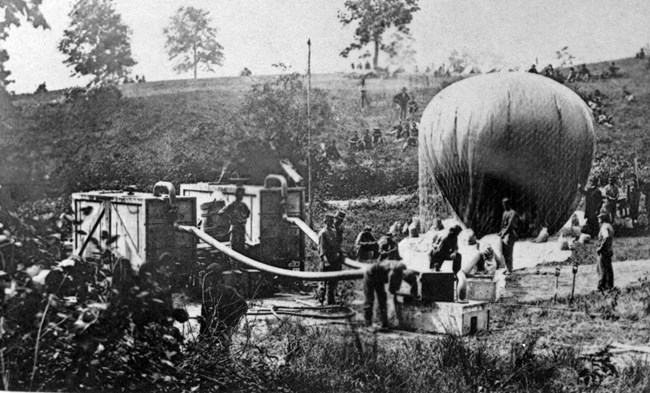
The largest Union balloons, the Intrepid and the Union each had a capacity of 32,000 cubic feet of lifting gas. Gas needed to fill these crafts was supplied by special hydrogen-generating inflation wagons and could could carry up to five people. Smaller, more portable baloons were used in the west, including the Eagle here at Island Number Ten carried only a single person.
Unfortunately, in this case, hazy weather prevents a clear picture being obtained and relayed down to the men on the ground, but by the beginning of April, it is apparent that the mortar shelling alone will not be able to destroy the enemy's defenses, provoking Army men to joke that the Navy's only contribution to the campaign is, "bombarding the State of Tennessee at long range."
Meanwhile the Union engineers completed the 12 miles of canal in just 19 days. The finished passage allowed for the draft of steamboats and barges, but not gunboats. Meanwhile, Pope kept pressuring Admiral Foote, as he had throughout the past few weeks to just try and to run his ironclads past the island. But because this was an era with zero joint command, the Army could not force the Navy to do something it didn't want to do, and vice versa. Unified command this was not, and Foote was a bit gun shy from the Battle of Fort Donelson where his ships, and himself personally, got pretty banged up trying to attack heavy fortification head on. Foote was on crutches this whole campaign, but finally, Commander Henry Walke, captain of Carondelet, volunteered for the mission to try and run past Island Number Ten after a meeting on 29 March.
Foote finally bowed to pressure and agrees to risk one of his Western Flotilla gunboats to break the stalemate. Commander Henry Walke of the USS Carondelet wins permission to test whether the enemy's batteries can be evaded - a maneuver that lower-ranking sailors already believed would surely succeed. To improve Walke's chances, Colonel George Washington Roberts of the 42nd Illinois and forty picked men launch a nighttime raid on Rucker's Battery on the Tennessee shore. Cloaked by a rainstorm, the Federals land, drive off two startled enemy pickets, and in a matter of minutes spike the guns and shove off to return to the squadron. Colonel Roberts' men are long out of sight by the time Confederate reinforcements wade through hip-deep water to reclaim the emplacement. The floating battery CSS New Orleans is the next obstacle to be removed, and on the morning of April 3rd, the Benton, Cincinnati, and three mortar boats concentrate their fire on it, scoring several direct hits. Fearing destruction, its commander cuts the mooring cables and the New Orleans to drift downstream to a safe ineffectual position two miles below the island. The next morning, the USS Carondelet is stripped for action: planks from a wrecked barge cover the unprotected deck to resist plunging shot; surplus chains are coiled over the vessel's most vulnerable parts, an 11-inch hawser is wound around the pilot house as far up as the viewing slits, and cord wood barriers are stacked about the boilers. Sailors are armed with pistols, hand grenades, and cutlasses, hoses are attached to the boilers to scald enemy boarders, and twenty-three sharpshooters from the 42nd Illinois supplement the crew. Additionally, a coal-laden barge stacked high with baled hay is tied to the port side, which is the side that will be facing the guns of Island Number Ten as she attempts to run past the fort. Near 10:00 PM, the moonless night of April 4th unexpectedly erupts with a violent thunderstorm as the Carondelet moves into the current. The gun ports are sealed, all orders are whispered, and the only light permitted is a lantern in the engine room. Shrouded in rain, Carondelet passes the Tennessee emplacements unchallenged, but when just opposite the island emplacements, the collected soot in one of the smokestacks, no longer dampened by steam exhaust vapor, "burned out", sending flames shooting out the chimney.
Confederate sentries open fire, sending artillerists running through the downpour. However, the Rebel gunners have great difficulty gauging the range between flashes of lightning, and each cannon rarely has a chance to fire more than two shots. Piloted by twenty-year old river veteran William R. Hoel, the USS Carondelet and its ungainly coal barge grazes the shallows near the head of the island, but buoyed by the swift current, regains the main channel. Once past the island, confrontation with the floating battery New Orleans proves anti-climactic as the hulk fires only a few ineffective shots. Greeted by welcoming bonfires to mark her arrival at New Madrid, the Carondelet embarrassingly suffers her only mishap of the night by running aground fifty yards from berthing. Shifting astern, the crew and the forward guns allow the lightened bow to swing free, and the gunboat safely moors at 1:00 AM, having taken two hours in passage and one hour aground. Rebel guns had fired some forty-seven shots, but only two solid projectiles managed to lodge into the coal barge. That same night General Pope had received the additional cheering news that his transports had made it through Bissell's channel and were now waiting concealed in Wilson's Bayou.
As April 5th dawns, army staff officers board the Carondelet to do some reconnaissance on the enemy fortifications twenty miles downriver and on the return trip, the gunboat delays long enough to shell an enemy emplacement opposite Point Pleasant and sends a squad ashore to spike the cannons after the defenders hastily withdraw. Pope immediately requests that a second ironclad be sent to him, and Foote grudgingly agrees. On the night of April 6th, under cover of another serendipitous thunderstorm, the Pittsburg makes a successful dash past Island Number Ten, arriving at New Madrid undamaged at 5:00 AM the next day.
The same night, four transport steamers were brought through the newly constructed canal. The presence of the gunboats and the threat of Pope’s soldiers crossing the river below Island No. 10 forced Mackall to withdraw farther inland. Retreating overland and cut off below on the river, the Confederates sank the gunboat Grampus and six other transports to prevent them falling into enemy hands. On 7 April, two Confederate officers surrendered the isolated river battery at Island No. 10 to Foote.
With vessels now able to safely move past the island, on April 7th, the gunboats move to destroy the Confederate batteries at Watson's Landing, the place Pope had selected for the attack on Island Number Ten. With General Mackall's forces being surrounded by the Union on all sides, and the plan for a Confederate retreat dashed, the Confederates raise the white flag over Island Number Ten on April 8th. The Union has just won a decisive victory on the Mississippi, and it is the first major step in reopening the mighty river to Union traffic.
The Union victory at Island Number Ten marked the first time the Confederate Army lost a position on the Mississippi River in battle instead of preemptively retreating like they had just upriver at Columbus, Kentucky A huge stretch of the river was now open to the Union Navy as far as Fort Pillow, about 60 miles southwest as the crow flies, and only a few miles upriver from Memphis, TN. Simultaneously, Admiral David G. Farragut was preparing to attack the Mississippi from the south. I think I did a pretty good job at covering the capture of New Orleans at the mouth of the Mississippi in my original overview of the Civil War a few years ago, it was my sixth ever episode so you can scroll way back and listen to that if you have not already, but long story short, only three weeks later, New Orleans fell and the Mississippi was not being squeezed from both directions and in danger of being cut in two along the line of the river.
"As for the battle itself, only a few hundred Confederate soldiers managed to escape. Pope claimed in his official reports that he had taken 273 officers and 6,700 private soldiers captive, but this is probably an exaggeration. Confederate records indicate that 5,350 men were present to be captured, but the records were a bit spotty themselves, so the real number is a bit of a historical mystery.

Aside from the prisoners taken, the number of casualties in the entire campaign was very low. From the fall of New Madrid to the surrender at Tiptonville, the Union army and navy had lost only 7 men killed from all causes, 4 missing, and 14 wounded. During the entire campaign, losses in the Army of the Mississippi were reported as 8 killed, 21 wounded, and 3 missing...

Island Number Ten was a major victory and started the steamroller south. But because because Pope's victory on April 7 coincided with the butcher's bill to the southeast along the Tennessee River, near a little church known as Shiloh, the campaign for Island No. 10 soon fell from public notice. The run of USS Carondelet past the batteries was a tactical innovation that we'll see was used throughout the rest of the war, and marked the decline in importance of fixed river defenses. We'll see that this tactic became commonplace in the Civil War. It was used by Farragut at New Orleans, Port Hudson, Vicksburg, and Mobile, and by David Porter at Vicksburg.
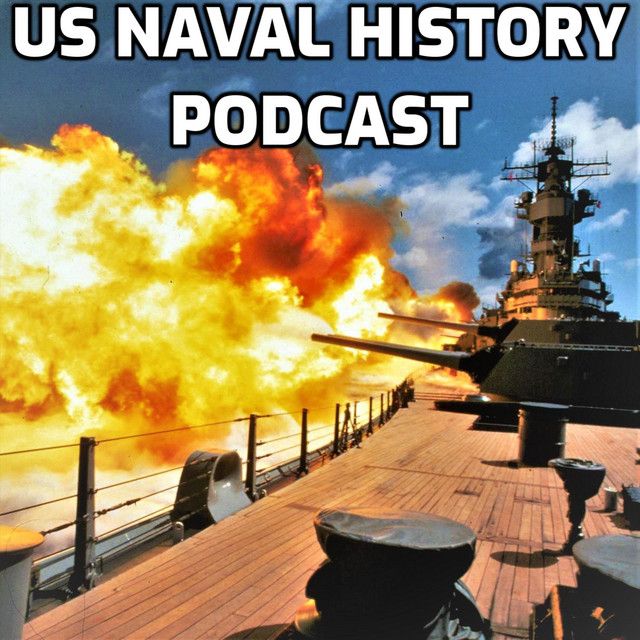
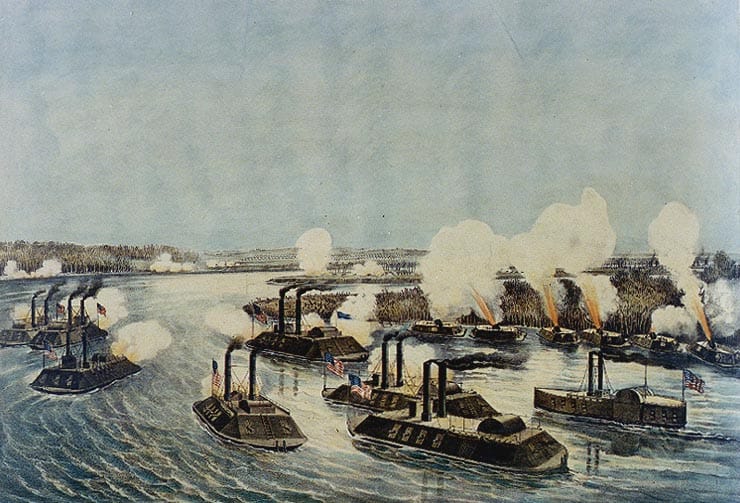

Member discussion: